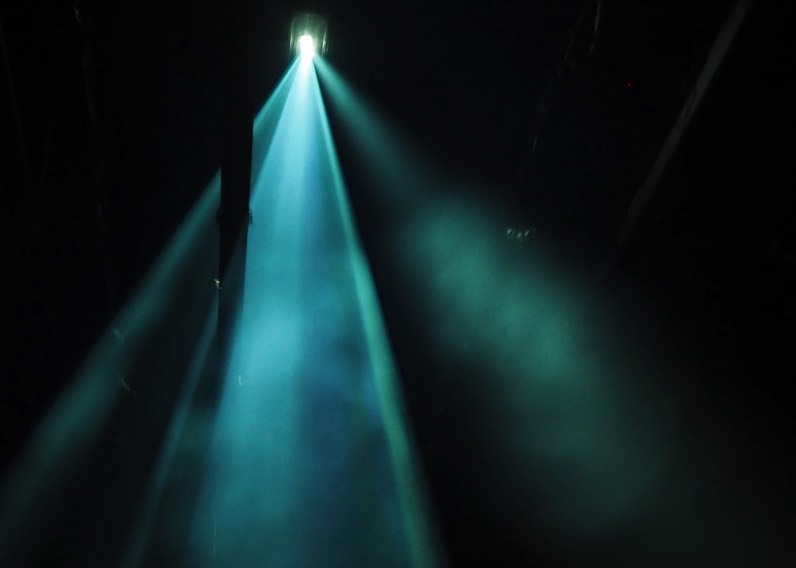The Glow that Illuminates, the Glare that Obscures
When we are close to something brilliant, what is the difference between that which lights our way, and that which impedes our journey?
The Glow that Illuminates, the Glare that Obscures explores the intricacies of an old love—Renaissance architectural and antiphonal musical practices—through new compositional forms and strategies. The work creates a ritualistic environment of morphing, ephemeral, aural architectures (sonic, visual, conceptual) that audience members explore during the performance.

The work exists in two versions:
Commissioner and Acknowledgments:
Concert version commissioned by Shriver Hall Concert Series for the American Brass Quintet.
Installation version commissioned by the Experimental Media Performing Arts Center (EMPAC) co-curated by Argeo Ascani, Leilehua Anne Lanzilotti, and Johannes Goebel.
Supported by New Music USA, made possible by annual program support and/or endowment gifts from Mary Flagler Cary Charitable Trust, Helen F. Whitaker Fund, the Aaron Copland Fund for Music, Inc, and the New York State Council on the Arts.
With special thanks to the Civitella Ranieri Foundation and the American Brass Quintet.
World Premiere of concert version:
December 8, 2019, American Brass Quintet and Nina C. Young, Shriver Hall, Baltimore MD
World Premiere of performative installation version:
[COVID postponed…TBD] - March 19, 2020, EMPAC
About the project:
Spending time in the chambers of ancient ruins and the cavities of basilicas and churches has led to a fascination with the interaction of architecture, light, and acoustics in relation to the human spectator. The different window types (from oculus to clerestory to stained glass) guide our relationships with the spaces, recanting visual stories as they divert beams of light in paths of illumination throughout the course of the day. The same is true of the sonic qualities of these, often vast, spaces. Within The Glow that Illuminates, The Glare that Obscures I take the brass performance tradition of the madrigals and motets of Renaissance polyphony and pass sourced quotations through a compositional prism. The resultant fragments are illuminated and obscured in the composition through the use of antiphonal and heterophonic writing, density and silence. Fragments of Josquin's Miserere, a spare and austere motet setting of Psalm 51, jostle our memory as they are stretched and ornamented throughout the ritualistic performance.
- ~20-minute concert version for brass quintet and electronics
- continuously generating audio-visual immersive installation version utilizing overhead wave field synthesis, light, and video projection
Commissioner and Acknowledgments:
Concert version commissioned by Shriver Hall Concert Series for the American Brass Quintet.
Installation version commissioned by the Experimental Media Performing Arts Center (EMPAC) co-curated by Argeo Ascani, Leilehua Anne Lanzilotti, and Johannes Goebel.
Supported by New Music USA, made possible by annual program support and/or endowment gifts from Mary Flagler Cary Charitable Trust, Helen F. Whitaker Fund, the Aaron Copland Fund for Music, Inc, and the New York State Council on the Arts.
With special thanks to the Civitella Ranieri Foundation and the American Brass Quintet.
World Premiere of concert version:
December 8, 2019, American Brass Quintet and Nina C. Young, Shriver Hall, Baltimore MD
World Premiere of performative installation version:
[COVID postponed…TBD] - March 19, 2020, EMPAC
About the project:
Spending time in the chambers of ancient ruins and the cavities of basilicas and churches has led to a fascination with the interaction of architecture, light, and acoustics in relation to the human spectator. The different window types (from oculus to clerestory to stained glass) guide our relationships with the spaces, recanting visual stories as they divert beams of light in paths of illumination throughout the course of the day. The same is true of the sonic qualities of these, often vast, spaces. Within The Glow that Illuminates, The Glare that Obscures I take the brass performance tradition of the madrigals and motets of Renaissance polyphony and pass sourced quotations through a compositional prism. The resultant fragments are illuminated and obscured in the composition through the use of antiphonal and heterophonic writing, density and silence. Fragments of Josquin's Miserere, a spare and austere motet setting of Psalm 51, jostle our memory as they are stretched and ornamented throughout the ritualistic performance.
Concert version premiere performance recording
11/16/22
© 2021 Nina C. Young
© 2021 Nina C. Young